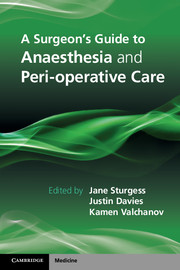37 results
Chapter 25 - Airway Management and Cervical Spine Disease
- from Section 4 - Neuroanesthesia
-
-
- Book:
- Gupta and Gelb's Essentials of Neuroanesthesia and Neurointensive Care
- Published online:
- 19 June 2018
- Print publication:
- 21 June 2018, pp 178-184
-
- Chapter
- Export citation
Chapter 24 - Fluids
-
-
- Book:
- A Surgeon's Guide to Anaesthesia and Peri-operative Care
- Published online:
- 05 July 2014
- Print publication:
- 05 June 2014, pp 273-276
-
- Chapter
- Export citation
List of abbreviations
-
- Book:
- A Surgeon's Guide to Anaesthesia and Peri-operative Care
- Published online:
- 05 July 2014
- Print publication:
- 05 June 2014, pp 317-319
-
- Chapter
- Export citation
Chapter 5 - Sedation
-
-
- Book:
- A Surgeon's Guide to Anaesthesia and Peri-operative Care
- Published online:
- 05 July 2014
- Print publication:
- 05 June 2014, pp 59-62
-
- Chapter
- Export citation
Chapter 28 - Physiology and risk in special circumstances
-
-
- Book:
- A Surgeon's Guide to Anaesthesia and Peri-operative Care
- Published online:
- 05 July 2014
- Print publication:
- 05 June 2014, pp 288-293
-
- Chapter
- Export citation
List of contributors
-
- Book:
- A Surgeon's Guide to Anaesthesia and Peri-operative Care
- Published online:
- 05 July 2014
- Print publication:
- 05 June 2014, pp vii-viii
-
- Chapter
- Export citation
Section I - Basic sciences
-
- Book:
- A Surgeon's Guide to Anaesthesia and Peri-operative Care
- Published online:
- 05 July 2014
- Print publication:
- 05 June 2014, pp -
-
- Chapter
- Export citation
Section II - Anaesthesia and peri-operative care for surgical specialties
-
- Book:
- A Surgeon's Guide to Anaesthesia and Peri-operative Care
- Published online:
- 05 July 2014
- Print publication:
- 05 June 2014, pp -
-
- Chapter
- Export citation
Section III - At a glance
-
- Book:
- A Surgeon's Guide to Anaesthesia and Peri-operative Care
- Published online:
- 05 July 2014
- Print publication:
- 05 June 2014, pp -
-
- Chapter
- Export citation
Chapter 8 - Colorectal cases
-
-
- Book:
- A Surgeon's Guide to Anaesthesia and Peri-operative Care
- Published online:
- 05 July 2014
- Print publication:
- 05 June 2014, pp 91-101
-
- Chapter
- Export citation
Chapter 2 - System-specific physiology
-
-
- Book:
- A Surgeon's Guide to Anaesthesia and Peri-operative Care
- Published online:
- 05 July 2014
- Print publication:
- 05 June 2014, pp 13-34
-
- Chapter
- Export citation

A Surgeon's Guide to Anaesthesia and Peri-operative Care
-
- Published online:
- 05 July 2014
- Print publication:
- 05 June 2014
Chapter 25 - Coagulation
-
-
- Book:
- A Surgeon's Guide to Anaesthesia and Peri-operative Care
- Published online:
- 05 July 2014
- Print publication:
- 05 June 2014, pp 277-280
-
- Chapter
- Export citation
Chapter 30 - Nerve injury
-
-
- Book:
- A Surgeon's Guide to Anaesthesia and Peri-operative Care
- Published online:
- 05 July 2014
- Print publication:
- 05 June 2014, pp 298-301
-
- Chapter
- Export citation
Chapter 17 - Neurosurgery cases
-
-
- Book:
- A Surgeon's Guide to Anaesthesia and Peri-operative Care
- Published online:
- 05 July 2014
- Print publication:
- 05 June 2014, pp 197-207
-
- Chapter
- Export citation
Contents
-
- Book:
- A Surgeon's Guide to Anaesthesia and Peri-operative Care
- Published online:
- 05 July 2014
- Print publication:
- 05 June 2014, pp v-vi
-
- Chapter
- Export citation
Chapter 22 - Scoring systems
-
-
- Book:
- A Surgeon's Guide to Anaesthesia and Peri-operative Care
- Published online:
- 05 July 2014
- Print publication:
- 05 June 2014, pp 259-268
-
- Chapter
- Export citation
Chapter 32 - Enhanced recovery
-
-
- Book:
- A Surgeon's Guide to Anaesthesia and Peri-operative Care
- Published online:
- 05 July 2014
- Print publication:
- 05 June 2014, pp 310-311
-
- Chapter
- Export citation
Frontmatter
-
- Book:
- A Surgeon's Guide to Anaesthesia and Peri-operative Care
- Published online:
- 05 July 2014
- Print publication:
- 05 June 2014, pp i-iv
-
- Chapter
- Export citation
Index
-
- Book:
- A Surgeon's Guide to Anaesthesia and Peri-operative Care
- Published online:
- 05 July 2014
- Print publication:
- 05 June 2014, pp 320-329
-
- Chapter
- Export citation



